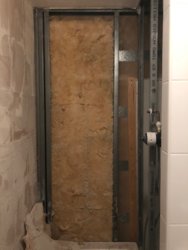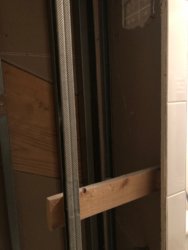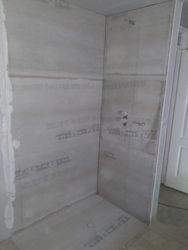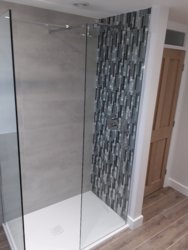schismatic
TF
- Reaction score
- 5
I'm currently redoing my shower. It's a 3-walled shower enclosure and so far I've removed the old tiles and water-damaged plasterboard which was there previously (15mm British Gypsum plasterboard). It's a new build house (2006) and I'm now left with the metal studding (think it's again standard British Gypsum 'C' shape stuff) (see attached photo).
I intend to put up tile backing boards as the replacement walls, attaching them to the existing metal studs and I need to have the new walls join/butt up against the existing plasterboard so that they are flush. Outside of the existing shower cubicle the rest of the room is also tiled and I'm retaining those, so the new walls need to finish flush with the existing 15mm plasterboard upon which those tiles are mounted.
My issue is matching the wall thickness of the new tile backing boards with the existing 15mm plasterboard. I was going to use Hardiebacker 250 (6mm thick) originally, however if these are flush with the existing 15mm walls then I will then be left with a 9mm gap between the tile backer board and the metal studs.
Would I be ok to put up 9mm thick batons horizontally between the existing studs and then mount the 6mm Hardiebacker on these?
If this is a good way to do it, how many batons should I use, how wide (height-wise) should each one be, and what material should I use? (ply or hardwood I was thinking, seeing as it shouldn't see a moisture environment after sealing properly and tiling)
In the close-up attached photo you can see the tiles on the right-hand side mounted on the 15mm plasterboard and the metal studding where the shower walls will be. That is on the right-hand side in the other photo looking straight on.


I intend to put up tile backing boards as the replacement walls, attaching them to the existing metal studs and I need to have the new walls join/butt up against the existing plasterboard so that they are flush. Outside of the existing shower cubicle the rest of the room is also tiled and I'm retaining those, so the new walls need to finish flush with the existing 15mm plasterboard upon which those tiles are mounted.
My issue is matching the wall thickness of the new tile backing boards with the existing 15mm plasterboard. I was going to use Hardiebacker 250 (6mm thick) originally, however if these are flush with the existing 15mm walls then I will then be left with a 9mm gap between the tile backer board and the metal studs.
Would I be ok to put up 9mm thick batons horizontally between the existing studs and then mount the 6mm Hardiebacker on these?
If this is a good way to do it, how many batons should I use, how wide (height-wise) should each one be, and what material should I use? (ply or hardwood I was thinking, seeing as it shouldn't see a moisture environment after sealing properly and tiling)
In the close-up attached photo you can see the tiles on the right-hand side mounted on the 15mm plasterboard and the metal studding where the shower walls will be. That is on the right-hand side in the other photo looking straight on.






